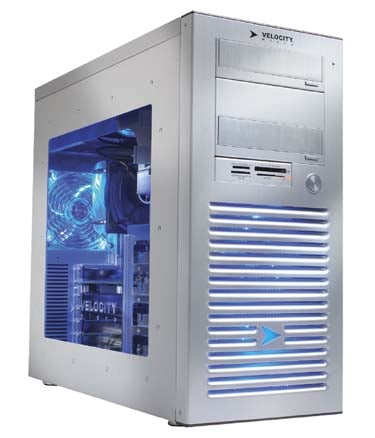Velocity Micro Edge Z55 Intel Core i7 Gaming System
Introduction & Specifications

Whenever AMD or Intel release a new processor and chipset platform, you can bet there’s going to be a good amount of excitement surrounding the release, along with anticipation as we eagerly await the arrival of systems that incorporate the new technologies. Velocity Micro’s new Edge Z55 Intel Core i7 Gaming System is out and we’ve had the chance to run it through our tests to see just how it stacks up. As you’ll see, the new Intel Core i7 CPU and X58 chipset enables the Velocity Micro Edge Z55 Gaming System to hold its own against the elite PCs of just a few months ago.
The new Core i7 brings with it new chipsets, motherboards, and a new LGA1366 processor socket. What sets the Core i7 processor apart from the other processors is its QuickPath Interconnect, which replaces Intel’s front side bus. This new 40-lane (20 each way), bi-directional serial link provides communication to Intel’s I/O hub and then fans out to PCI Express. The Core i7 also incorporates an integrated, triple-channel memory controller that offers over three times the memory bandwidth of the previous dual-channel controller at DDR3-1066. Intel also brought back Hyper-Threading Technology with the Core i7, which provides two logical threads per processor core, for a total of eight available processing threads in a quad core CPU.
Like many enthusiast system manufacturers, Velocity Micro makes hand-built, high-end gaming rigs using the latest components, such as Intel’s Core i7 processors. Velocity Micro claims that they pride themselves on their extensive customization options, meticulous assembly procedures, a technically trained staff, and in-house US-based support. Each system is hand-assembled by expert engineers and run through extensive testing to ensure complete functionality. As you’ll see, Velocity Micro’s engineers are also appear to be very careful about how they route and tie cables to ensure optimal airflow within the chassis.
Velocity Micro offers two series of gaming rigs—the Raptor and Edge series. The Raptor is “the best of the best” with more customization and tweaking options along with higher-end specs. The Raptor line offers two models: the Raptor Signature Edition (starting at $5,499) and the Raptor Z90 (starting at $3,599). The Edge series is also geared towards serious gaming enthusiasts, but strikes a balance between high-end specs and affordability. You’ll find five models in the Edge series: the Edge Z5 (starting at $859), Edge M10 (starting at $1,099), Edge Z15 (starting at $1,499), the Edge M40 (starting at $1,699), and the Edge Z55 (starting at $2,199).
Velocity Micro added a few options to our Edge Z55 test system, bringing the cost up to $2,399. Read on to see how the Edge Z55 Intel Core i7 Gaming System faired as we put the system through the usual level of rigorous HotHardware testing and hands-on evaluation.
 |
|
| Processor Intel Core i7 920 (quad 2.66GHz cores, 8MB Cache, 4.8GT/sec)
Lite-On 20x DVD+/RW- Dual Layer Burner with Lightscribe labeling Technology Floppy Drive 8-in-1 |
Case Power Supply 2 x PCI Express x1 1 x PCI slot 1 x PCI Express x4
2 x IEEE 1394 FireWire Ports (1 front, 1 rear) 1 x RJ45 Ethernet (10/100/1000) port 2 x eSATA ports analog and digital audio outputs Bundled/Installed Software CyberLink Live Premium Diskeeper Home Edition DivX Pro for Windows Norton 360 PLAYXPERT in-Game Platform FutureMark 3DMark Vantage - Velocity Micro Basic Edition Tom Clancy’s Ghost Recon 1-year parts and labor, depot repair (upgradeable to 4 years, on-site repair) 1 year phone support, business hours (upgradeable to 4 years, 24/7 phone support) Price: $2,399 USD (as configured) |
Our test Velocity Micro Z55 was powered by an Intel Core i7 920 processor (2.66GHz), over clocked to 2.93GHz. The system had an Intel "Smackover" DX58SO motherboard with the new LGA1366 processor socket and X58 Chipset. As mentioned, this system trades in the outdated front-side bus for Intel’s new QuickPath Interconnect technology. Our configuration’s 6GB of Corsair DDR3 memory runs at 1333MHz. For graphics, the system uses two ATI Radeon HD 4850 with 512MB GDDR3 running in CrossFire. NVIDIA cards running in SLI are also available for an additional fee but that also likely means a motherboard change.
The system we tested had a 750GB Hitachi 7200rpm hard drive, but if you’re looking for more storage, you can upgrade to up to 3TB of hard disk storage space or choose one of Velocity Micro’s solid state drive offerings. Our system came with two identical Lite-On 20x DVD+/RW- Dual Layer burners with Lightscribe labeling Technology. The system’s sound was powered by the 7.1-channel, integrated audio. Creative SoundBlaster X-Fi-based cards are available for an additional $45 to $75. To cool the CPU, Velocity Micro uses an Intel Certified High Performance Heatsink and air cooling. To cool the video cards, you can upgrade to a VideoCool positive-pressure airflow cooling system for an additional $35.
The Warranty -
Velocity Micro’s standard warranty includes one year of depot-based parts and labor warranty along with one year of regular business hour support from the company’s US-based tech support. Two-, three-, and four-year warranty options are available for an additional cost. On-site support and 24/7 phone support are also available as upgrades. Velocity Micro’s best warranty runs $369 and includes a four-year parts and labor warranty with on-site service and 24/7 phone support.
For a bit of future-proofing, Velocity Micro offers a “Lifetime Upgrade Plan,” which lets you return your system to the factory for basic interior cleaning, general maintenance, driver and BIOS updates, operating system updates, discounted component hardware upgrades, and standard performance tuning and benchmarking, regardless of if the system is under warranty or not. Prices for this service start at $99, plus shipping and handling charges, hardware component upgrades and material used, additional labor required, and return packaging material. Should you choose to upgrade components, the original parts from your system will be returned for you to reuse or resell.







